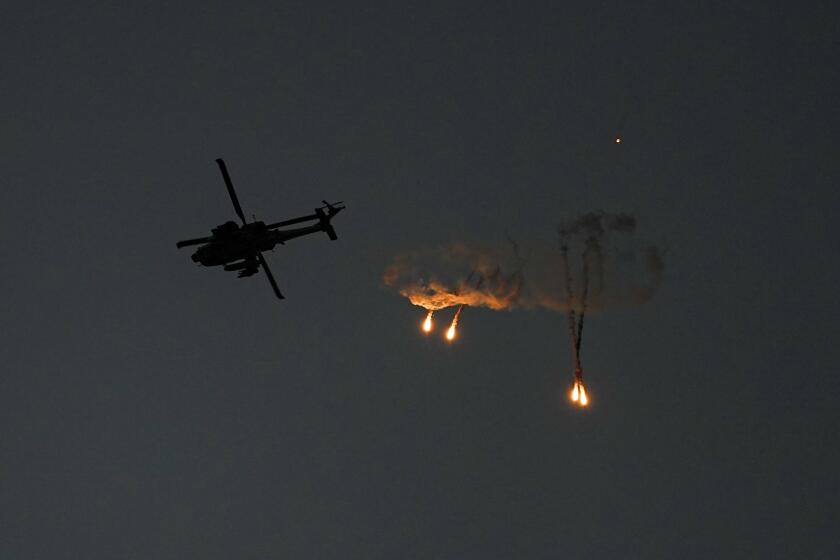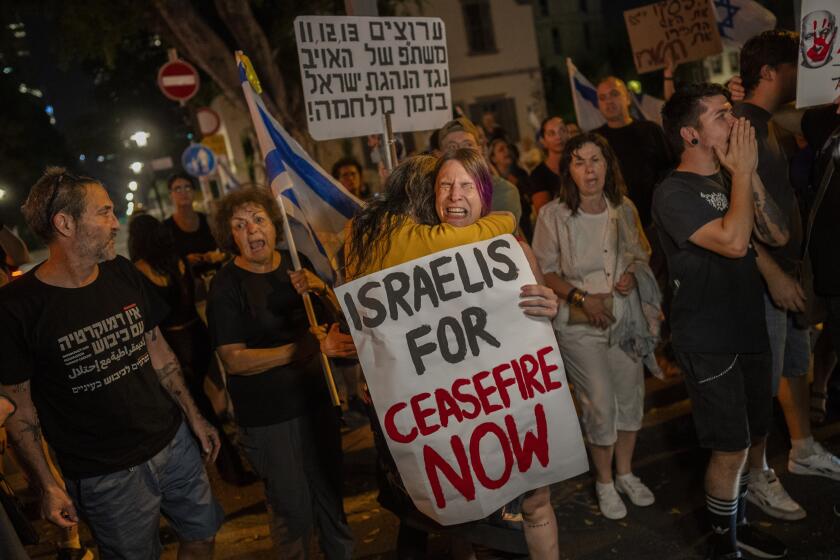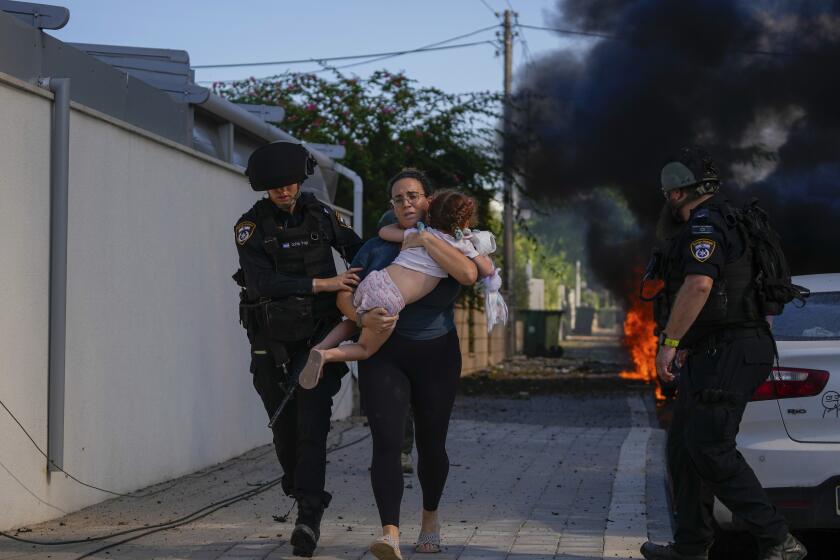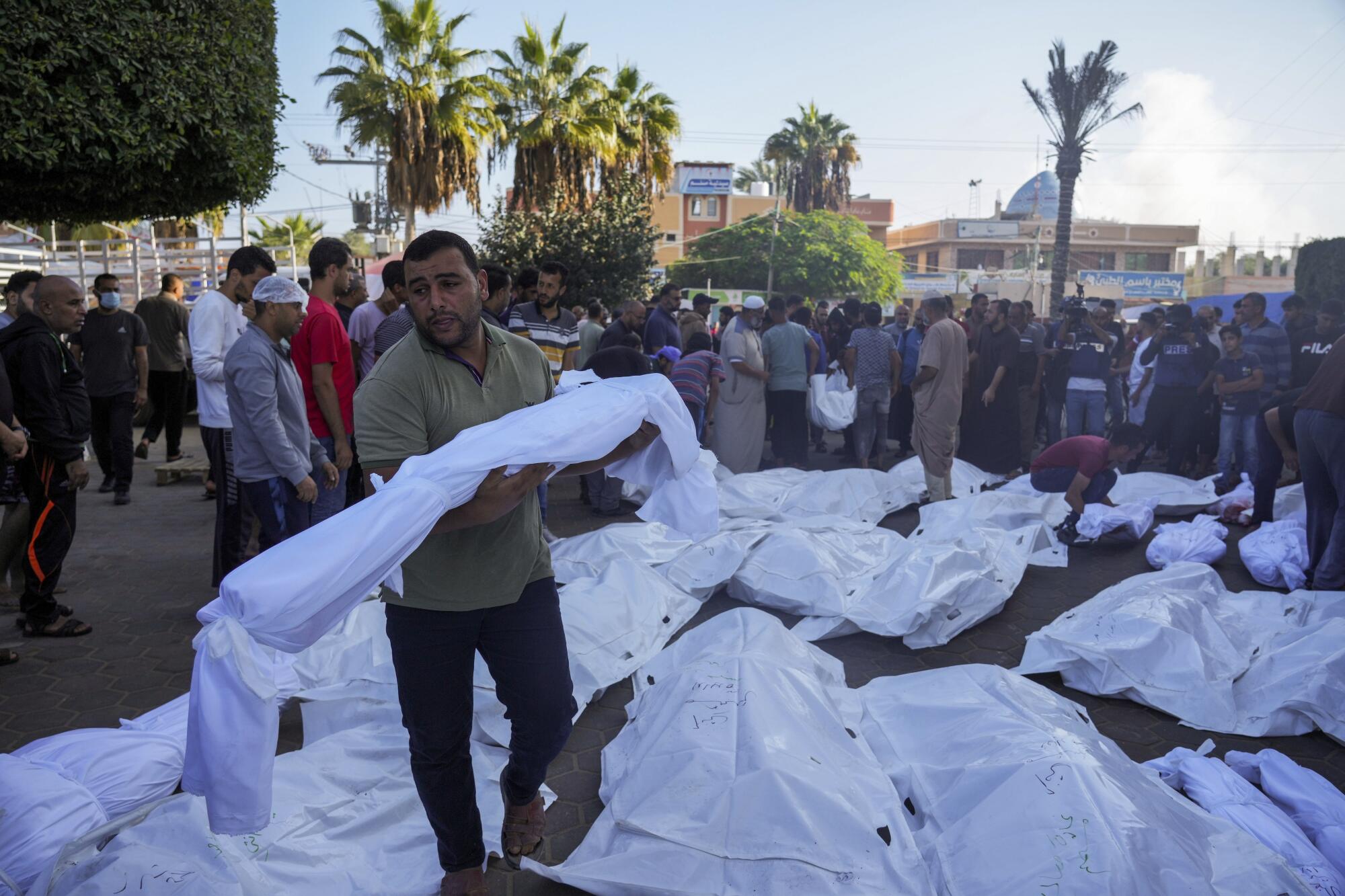
- Share via
KHAN YUNIS, Gaza Strip — The Israeli army severed northern Gaza from the rest of the besieged territory and pounded it with airstrikes Monday, preparing for expected ground battles with Hamas militants in Gaza’s largest city and an even bloodier phase of the month-old war.
Already, the Palestinian death toll surpassed 10,000, the Health Ministry of the Hamas-run Gaza Strip said Monday. The ministry does not distinguish between fighters and civilians. More than 1,400 Israelis have died, mostly civilians killed in the Oct. 7 incursion by Hamas militants that started the war.
The war has quickly become the deadliest Israeli-Palestinian violence since Israel’s establishment 75 years ago, with no end in sight as Israel vows to remove Hamas from power and crush its military capabilities.
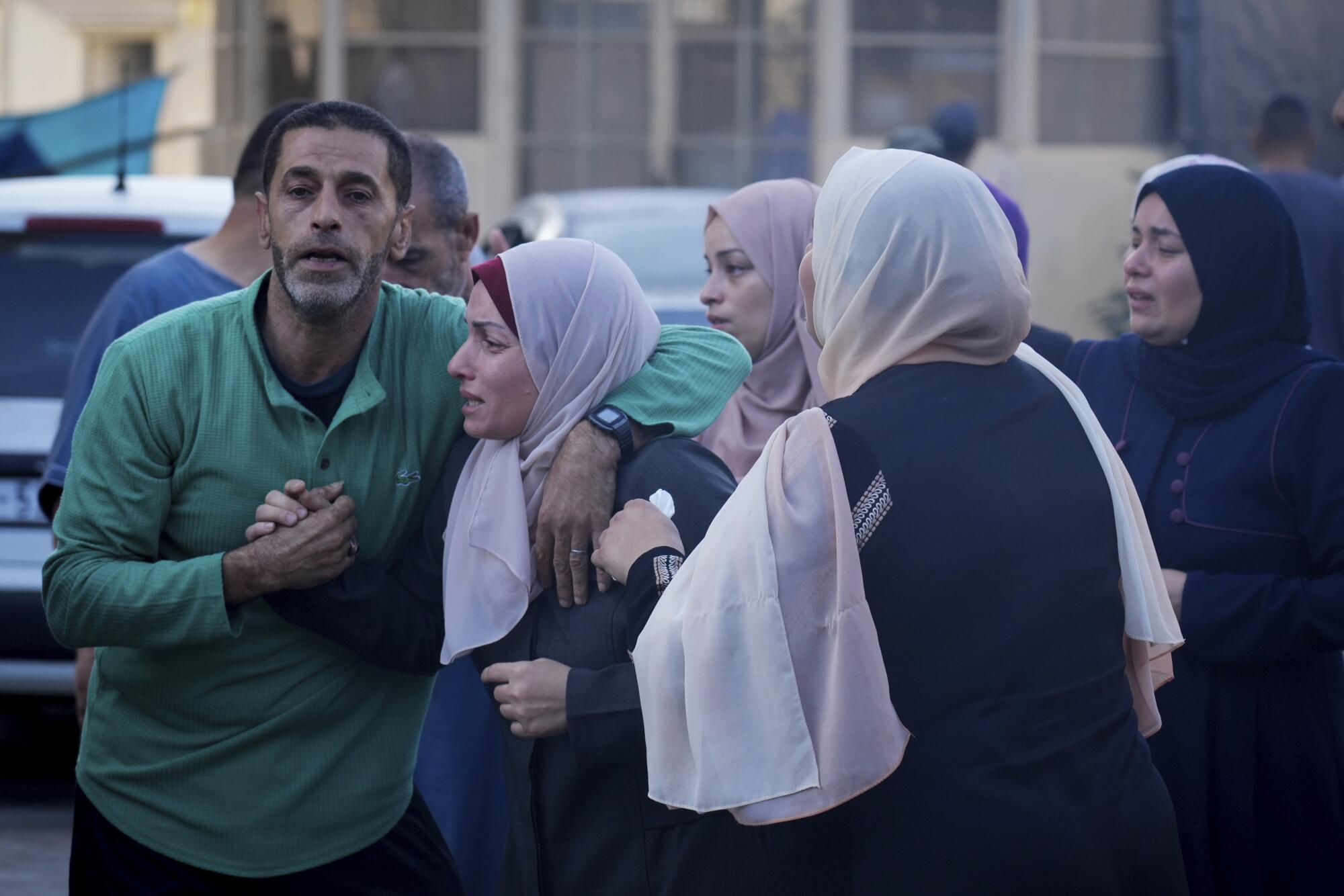
Casualties are likely to rise sharply as the war turns to close urban combat. Troops are expected to enter Gaza City soon, Israeli media reported, and Palestinian militants who have had years to prepare are likely to fight street by street, launching ambushes from a vast network of tunnels.
“We’re closing in on them,” said Lt. Col. Richard Hecht, an Israeli military spokesman. “We’ve completed our encirclement, separating Hamas strongholds in the north from the south.”
Several hundred thousand people are believed to remain in the north in the assault’s path. The military says a one-way corridor for residents of Gaza City and surrounding areas to flee south remains available. But many are afraid to use the route, part of which is held by Israeli troops.
In recent days, airstrikes have hit U.N. facilities where thousands are sheltering, as well as hospitals, which have been overwhelmed by wounded and running low on power and supplies.
A Times special correspondent in Gaza offers a personal account of living in a place where nowhere feels safe.
A strike early Monday hit the roof of Gaza City’s Shifa Hospital, killing a number of displaced people sheltering on its top floor and destroying solar panels, said Mohamed Zaqout, general manager of all hospitals in Gaza. The panels have been helping keep power on in the facility, which has been reduced to using one generator because of lack of fuel.
The strike came in what witnesses said was one of the heaviest nights of bombardment yet in northern Gaza. Israel said it struck 450 targets overnight, killing a number of Hamas military commanders. Israel blames civilian casualties on Hamas, accusing the militants of operating in residential neighborhoods.
The overnight barrages crushed homes, burying unknown numbers of people in the Shati refugee camp, a densely built-up district on the Mediterranean coast adjacent to central Gaza City, Palestinians who fled south Monday reported.
Ghassan Abu Sitta, a surgeon at Shifa Hospital, told the Associated Press the hospital buildings shook all night from the bombardment “and we started getting the bodies and the wounded. It was horrendous.”
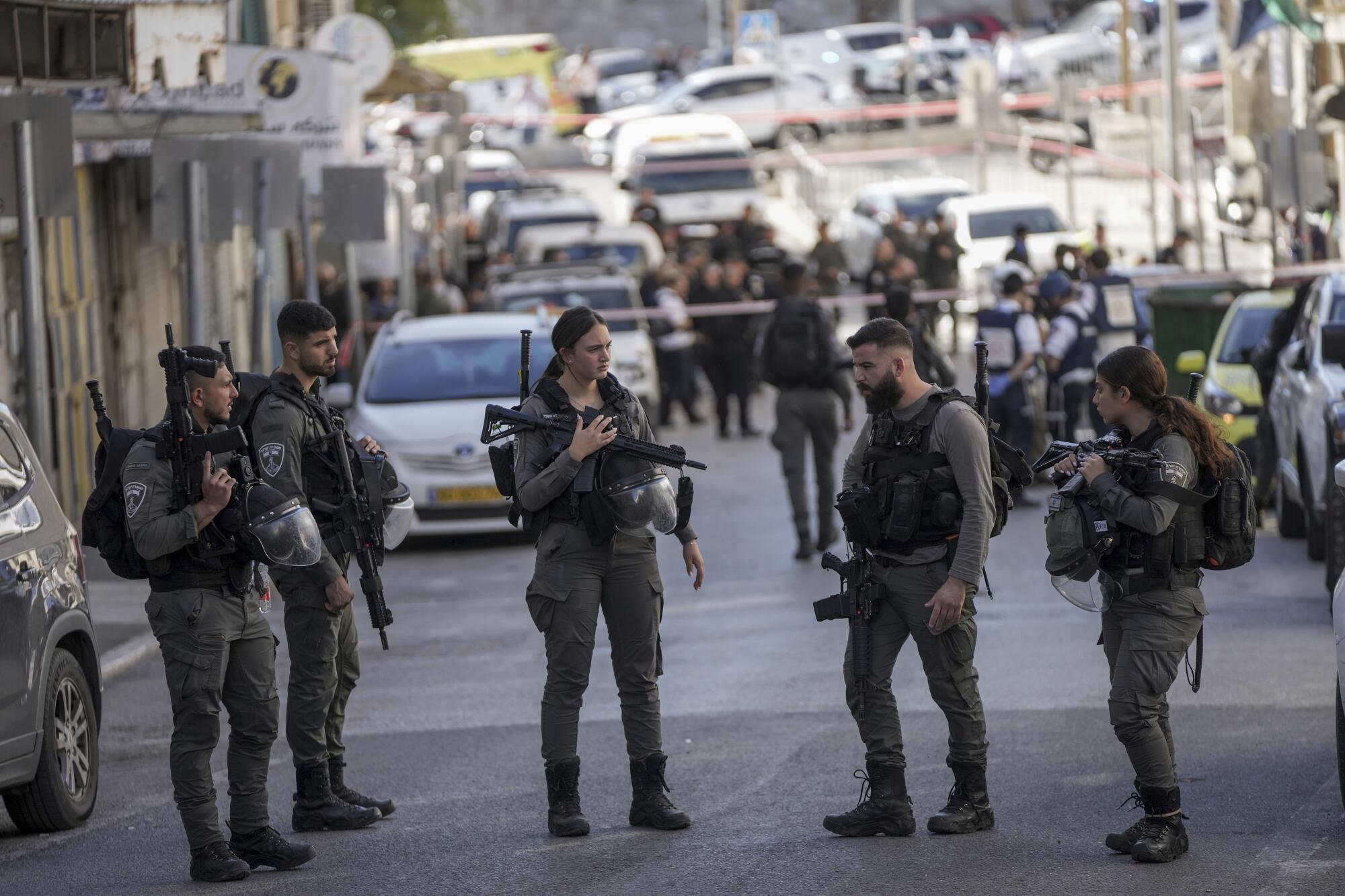
The military released videos that it said showed its ground troops uncovering Hamas rocket launchers in a youth center and near a mosque in northern Gaza. It did not provide the precise locations where the videos were made, and the images did not include any visible landmarks, so the AP could not independently confirm them.
Around 70% of Gaza’s 2.3 million residents have fled their homes since the war began. Food, medicine, fuel and water are running low, and U.N.-run schools-turned-shelters are beyond capacity. Many people are sleeping on the streets.
Cellphone and internet service went down overnight, the third territory-wide outage since the start of the war, but was gradually restored Monday.
U.S. President Biden raised the need for humanitarian pauses directly with Israeli Prime Minister Benjamin Netanyahu on a call Monday, but there was no agreement reached, the White House said.
A month after Hamas’ surprise attack nearly brought Israel to its knees, the country’s battered ‘peace camp’ is rising — or trying its best to do so.
So far, Israel has rejected U.S. suggestions for a pause, aimed at facilitating humanitarian aid deliveries and the release of some of the estimated 240 hostages seized by Hamas in its raid. Israel has also dismissed calls for a broader cease-fire from Arab countries.
After days of intense diplomacy around the Middle East, U.S. Secretary of State Antony J. Blinken wrapped up his tour of the region Monday. He said efforts to secure a pause, negotiate the hostages’ release and plan for a post-Hamas Gaza were still “a work in progress” without pointing to any concrete achievements.
The war has also stoked wider tensions, with Israel and Lebanon’s Hezbollah militant group trading fire along the border. In another sign of growing unrest, a Palestinian man stabbed two members of Israel’s paramilitary Border Police in East Jerusalem before being shot dead, according to police and an AP reporter at the scene. Police said one of the officers, a 20-year-old woman, was later pronounced dead.
In the occupied West Bank, Israeli forces shot to death four Palestinian men in a vehicle in the city of Tulkarm, the Palestinian Health Ministry said. The military said two of the men were high-ranking militants.

Israel captured East Jerusalem, along with Gaza and the West Bank, in the 1967 Middle East War. The Palestinians want all three territories for a future state. Israel annexed East Jerusalem in a move not recognized by most of the international community; it considers the entire city its capital.
In northern Gaza, a Jordanian military cargo plane air-dropped medical aid to a field hospital, King Abdullah II said early Monday. It appeared to be the first such airdrop of the war, raising the possibility of another avenue for aid delivery besides Egypt’s Rafah crossing.
More than 450 trucks carrying aid have been allowed to enter Gaza from Egypt since Oct. 21. But humanitarian workers say the aid is far short of mounting needs.
The crossing was closed Saturday and Sunday because of a dispute among Israel, Egypt and Hamas. But it reopened Monday and seven Palestinian patients were evacuated to Egypt, the International Committee of the Red Cross said.
Some 800,000 people have heeded Israeli military orders to flee to southern Gaza. But continued Israeli strikes in central and southern Gaza — the purported safe zone — killed dozens of people Sunday.
The U.N. says it is collecting evidence of war crimes by all sides in the Israel-Hamas conflict. But holding perpetrators to account is often difficult.
After another strike Monday, in the southern town of Khan Yunis, men dug through the rubble with sledgehammers and their bare hands. A young boy caked in dust screamed as he was rolled onto a stretcher and carried away. At least two people were killed, according to an AP reporter at the scene.
Earlier Monday, Palestinians held a mass funeral for 66 people laid out on the ground outside a hospital morgue in the central town of Deir al Balah. A man with bandages wrapped around his head placed his hand on a child’s body and wept.
The Health Ministry said that 10,022 people have been killed in Gaza, including more than 4,100 children and 2,600 women. More than 2,300 people are missing and believed to be buried under the rubble of destroyed buildings, the ministry said.
The Israeli army said 30 Israeli troops have been killed since the ground offensive began over a week ago. Hamas and other militants have continued firing rockets into Israel, disrupting daily life even as most are intercepted or fall in open areas. Tens of thousands of Israelis have evacuated from communities near the volatile borders with Gaza and Lebanon.
Jeffery and Keath reported from Cairo. Wafaa Shurafa in Deir al Balah, Gaza; Samy Magdy in Cairo; Amy Teibel and Sam McNeil in Jerusalem; and Kareem Chehayeb and Bassem Mroue in Beirut contributed to this report.
More to Read
Sign up for Essential California
The most important California stories and recommendations in your inbox every morning.
You may occasionally receive promotional content from the Los Angeles Times.
